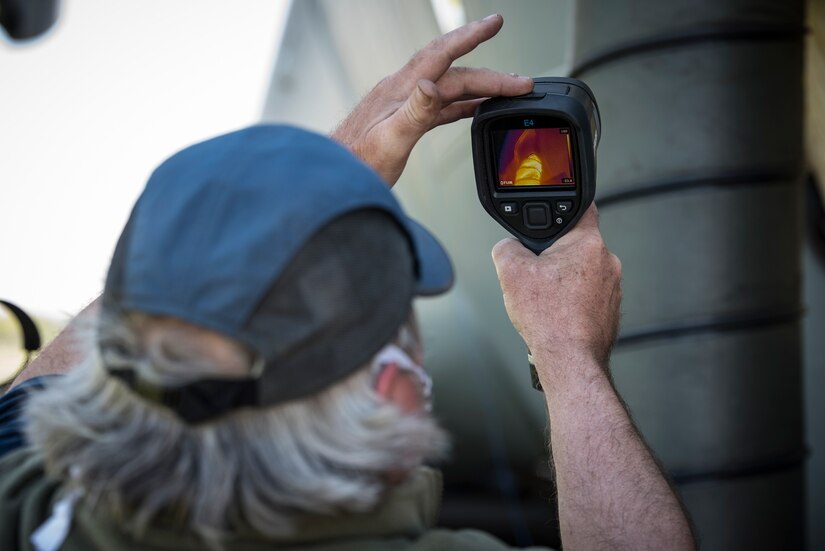Researchers from the AFRL's 711th Human Performance Wing are looking into the ability of using common ground heaters to raise the interior temperature of a C-17 transport aircraft enough to kill viral agents. These heaters are found at every military installation, where they are commonly used by maintenance crews to keep warm or to heat equipment.

''Our goal with this test was to demonstrate the ability for any Air Force base to assist with aircraft disinfection utilizing only commonly available equipment and materials,'' said Dr. Doug Lewis, the team lead with the 711th Human Performance Wing Protection Systems, who is heading the effort. ''We knew that if we could prove the ability of this equipment to heat aircraft interiors to temperatures in the 120 degree range, we were potentially demonstrating an Air Force-wide disinfection capability, pending further laboratory results.''
Over two separate test events conducted in May, Lewis and his team placed an array of sensors and measurement equipment inside a C-17 and carefully sealed it using materials common to military installations. Hoses from the ground heaters were directed inside, and the temperature was raised for a period of six hours per test. Through this setup, researchers successfully heated the interior up to 50 degrees above ambient temperature.
The team is working in coordination with Battelle, a research and development organization based in Columbus, Ohio, to test the effectiveness of heat to inactivate the COVID-19 virus. Preliminary results from Battelle indicate that the temperatures reached during the AFRL tests were sufficient to disable the virus to safe levels on surfaces materials such as aluminum, silicon and nylon webbing.

Lewis says the team will conduct further tests and continue to work with Battelle to investigate additional test parameters representative of operational conditions. The future tests will look into the effectiveness of heating the interior for less than six hours, as well as the effects of various ambient humidity and temperature conditions.
Lewis called the initial results a positive indicator of the ability to use commonly available equipment to help eliminate the COVID-19 viral threat on aircraft. He said the team is developing recommended implementation procedures, including solutions for environmental conditions that fall below the threshold required to reach the optimal disinfection range. This may include the recommendation to perform the procedure in heated hangars.
Although this approach is new, the concept of heat disinfection for aircraft is not. The AFRL-developed Joint Biological Aircraft Decontamination System, or JBADS, is a currently-employed technology that similarly relies on heat and humidity to disinfect aircraft interiors. This system encloses an aircraft fully, like an aircraft ''oven,'' heating to temperatures of 140 to 180 degrees and disinfecting the entire interior, including difficult-to reach surfaces.
The JBADS team has also achieved success in optimizing the system to eliminate the COVID-19 threat. However, since this process involves highly specialized equipment, JBADS is not widely available enough to be used immediately as a go-to solution for the COVID-19 disinfection across the entire military aviation community. Conversely, ground heaters are a common and widely available resource that can be repurposed toward this goal.
In addition to reaching otherwise inaccessible surfaces, controlled heat disinfection will not adversely affect electronics and sensitive equipment, as some disinfectants might. Lewis said he was pleased with the test results and foresees it as a viable low-cost solution for the disinfection of COVID-19 and other viral agents as well.

''With this test, we have demonstrated the widespread capability to disinfect military assets utilizing only commonly available equipment and materials,'' Lewis said. ''It is a relatively simple solution that can be implemented immediately for the safety of military crews.''
Lewis also noted that heat disinfection is only one approach AFRL and partner organizations are looking into to assist in COVID-19 flight safety. He and a vast team of researchers are looking at various solutions, including chemicals, common soaps and household cleaning items, ultraviolet light, ionization and simply ''airing out'' aircraft between missions. Many of these potential solutions could be employed alone or together to achieve the desired results.
''Our goal is to prove the efficacy of a process that can be easily and quickly replicated throughout the Air Force to provide safety for our air crews,'' Lewis said.
(Holly Jordan is assigned to the Air Force Research Laboratory.)






No comments:
Post a Comment